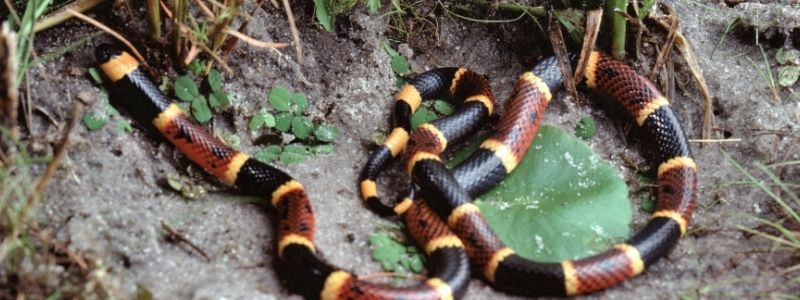Most Common Snakes in Hill Country
Snakes serve a useful purpose in the environment. Snakes never prey on humans, and they will never run after you; in fact, they generally retreat or escape if given a chance. The danger comes once they are either shocked or cornered. Most bites result from individuals taking unreasonable risks with venomous snakes. Stay still when snakes are known to be close by until you know where they are. Let the snake retreat or if you need to move back, do it slowly and carefully away from the snake.
Western Diamondback Rattlesnake
The Western diamondback rattlesnake is a heavy-bodied snake that has a triangular-shaped head. You can find two dark diagonal lines on each section of its face running from the eyes to its jaws. This snake’s tail has black and white bands just above its rattles.
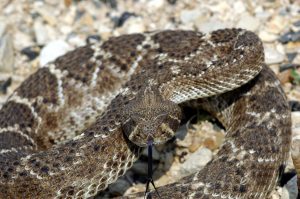 Western diamondback rattlesnake can be found in a wide range of habitats, including grasslands, rolling plains, thorn scrub, deserts, and rocky canyons. Spots like trash piles and junkyards can often give refuge for many vermin, such as mice and rats. Sites such as these in rural locations may appeal to rattlesnakes and other snakes as well.
Western diamondback rattlesnake can be found in a wide range of habitats, including grasslands, rolling plains, thorn scrub, deserts, and rocky canyons. Spots like trash piles and junkyards can often give refuge for many vermin, such as mice and rats. Sites such as these in rural locations may appeal to rattlesnakes and other snakes as well.
Hognose Snake
Hognose snake (genus Heterodon), any of three types of North American nonvenomous snakes that belong to the family Colubridae. This snake is sometimes called “puff adders.” They are named for the upturned snout, which they use for digging.
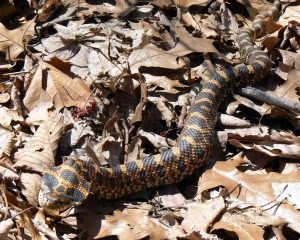 When in danger, they flatten their head and neck, then attack with a loud hiss. Eventually, they will play dead, rolling on their back and opening up their mouth. Hognose snakes almost never bite.
When in danger, they flatten their head and neck, then attack with a loud hiss. Eventually, they will play dead, rolling on their back and opening up their mouth. Hognose snakes almost never bite.
Coral Snakes
Coral snakes are small and vibrantly colored, highly venomous snakes. They have the second-strongest venom of any snake, but they are generally regarded as less hazardous than rattlesnakes since coral snakes have a less effective poison-delivery system. Coral snakes are really reclusive and usually bite humans only if handled or stepped on.
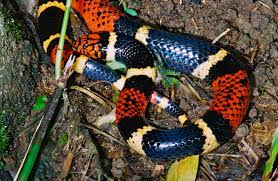 Coral Snakes eat frogs, lizards, and smaller snakes, including many other coral snakes. Baby coral snakes emerge from the eggs 7 inches in length, and they are already fully venomous. Adult coral snakes can reach about 2 feet in length. The average lifespan in the wild is usually unidentified, but they can live up to seven years in captivity.
Coral Snakes eat frogs, lizards, and smaller snakes, including many other coral snakes. Baby coral snakes emerge from the eggs 7 inches in length, and they are already fully venomous. Adult coral snakes can reach about 2 feet in length. The average lifespan in the wild is usually unidentified, but they can live up to seven years in captivity.
Copperhead
These large snakes, seen through the eastern and southern United States, have bodies that vary from tan to copper to gray, with typical hourglass-shaped stripes. These reptiles develop to lengths between two and three feet, even though there are records of them longer than four feet.
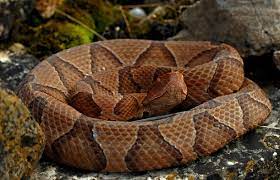 Their stout body shapes abruptly taper towards their thin tails. They can also tolerate living in subdivisions and developed territory, making interactions with humans much more common.
Their stout body shapes abruptly taper towards their thin tails. They can also tolerate living in subdivisions and developed territory, making interactions with humans much more common.
Texas Rat Snake
The Texas rat snake is one of the most regularly encountered species of nonvenomous snake in Hill Country. They have spotted-brown to olive-green colors with hues of yellow, orange, and oftentimes red-perfect camouflage for tree-living. They are big snakes capable of growing more than 2 m in total body length. The largest one recorded measured 2. 18 m.
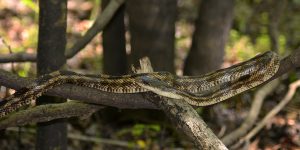 Irrespective of their size, Texas rat snakes are nonvenomous and pose no threat to people. This species is usually highly adaptable to a wide range of surroundings, including forest, grasslands, suburban areas, and areas within an urban location.
Irrespective of their size, Texas rat snakes are nonvenomous and pose no threat to people. This species is usually highly adaptable to a wide range of surroundings, including forest, grasslands, suburban areas, and areas within an urban location.
Coachwhips
Coachwhips are among the lengthiest snakes in the region, reaching more than 8 feet. Their pigmentation is incredibly distinct, fading slowly from black on the head to tan or close to white on the tail. The pattern of scales on the tail looks like some sort of braided whip, giving the snake its common name.
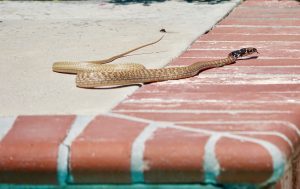 Young coachwhips are very slender and absolutely tan with irregular darker bands and white-colored markings on the face and neck. Coachwhips have big eyes and superb vision.
Young coachwhips are very slender and absolutely tan with irregular darker bands and white-colored markings on the face and neck. Coachwhips have big eyes and superb vision.
Dekay’s Brownsnake
The Dekay’s brownsnake is brown, light brown, or grey in color. It has two parallel rows of tiny dark spots bordering a faint, wide stripe down the back. On some brownsnakes, these parallel spots ay look connected. The belly is outlined with black flecks and is typically light brown but usually pinkish or tan. This species also has a dark stripe on both sides of the neck in the back of the eyes and another below each eye.
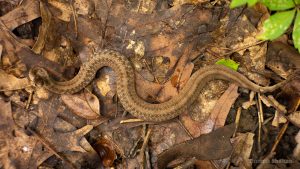 Brownsnakes live in the surface litter in many habitats, which include oak savannas, southern lowland hardwoods, prairies, marshes, old farms, and under trash in vacant town lots. Small invertebrates, including slugs, earthworms, and snails are among
Brownsnakes live in the surface litter in many habitats, which include oak savannas, southern lowland hardwoods, prairies, marshes, old farms, and under trash in vacant town lots. Small invertebrates, including slugs, earthworms, and snails are among

